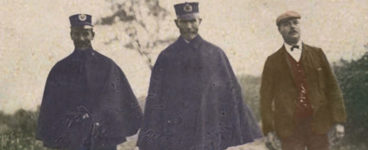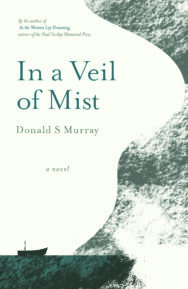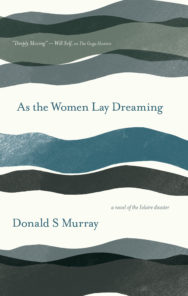‘But they don’t ask direct questions about what they’ve witnessed. Whatever is happening, it is hardly the most important thing in either of their lives.’
Donald S Murray shed light on the Iolaire disaster in his award-winning novel As the Women Lay Dreaming. David Robinson finds that Murray’s sense of place and its people is there once again in his new novel In a Veil of Mist and is just as beautifully drawn.
In a Veil of Mist
By Donald S Murray
Published by Saraband
Go to enough book festivals and there’s one question you’ll hear so often that it’s hard to stop your eyes rolling. ‘How important to your writing,’ the writer is asked, ‘is a sense of place?’ And the writer will nod furiously and say that yes, it’s so vital that it’s almost another character, when all they’ve really done is to sketch in a real-life location or scout Google Maps for a dash of background colour.
Donald S Murray’s new novel, In a Veil of Mist, set in his native Lewis as firmly as the stones at Callanish, is the opposite of this. Not only is the setting at least as important as the plot, but it is so credibly drawn that the book is almost a ticket to the island – and not only that, but to the Lewis of 1952 and to a secret it has largely kept to itself ever since. As I read the book, I found myself pondering the whole business of place. How do you actually go about creating such solidly believable settings for fiction? Can outsiders ever do it? Suppose they took precisely the same subject, what might they miss?
First of all, the background. It’s 1952, and a team of biological warfare specialists are conducting experiments on monkeys and guinea pigs on a converted tank landing ship off the north-east coast of Lewis. The Russians are streets ahead in testing killer gases, so this is us trying to catch up. Bomblets releasing the gases are exploded in the air a mile or so offshore, and the effects on animals placed on a pontoon underneath are studied. There are warning flags everywhere and nearby ships have been instructed to stay clear of the area. Yet word hasn’t reached the crew of an approaching trawler, or if it has, they’ve disregarded it. So on they sail, through the titular veil of mist, making their potentially deadly way through the Minch. Breathe in, and the crew could be inhaling brucellosis or tularaemia or seeding the bubonic plague in the populace the next time they step ashore.
For many novelists, one way of telling this story would be to go the full Tom Clancy, immersing themselves in military technology and Cold War politics and using every last detail of the real-life Operation Cauldron that forms the basis of this story. But this is the antithesis of Murray’s style: his award-winning debut novel As the Women Lay Dreaming was so powerful not because it retold the story of the Iolaire tragedy with extra descriptive adjectives – the actual 1919 shipwreck was hardly mentioned – but because it showed how grief pulsed through subsequent generations of islanders too.
Another approach – and one that tempts him more – is to place the germ warfare experiments at the centre of a moral dilemma. For this, he introduces a Liverpudlian lab technician aboard the converted tank carrier whose wife finds his work abhorrent and wants him to quit. But even though most novelists would probably also create such a character, and furnish him with the necessary self-justifying arguments, those are just as obvious as the details of Operation Cauldron itself. Sense of place requires far more – and perhaps as with his previous novel, it only emerges obliquely: you only find it when you’re not directly looking for it.
For me, this is what makes Murray’s two other main characters – Jessie, a spinster in her fifties, or Duncan, a bus driver in his late twenties – so important. These two find the bodies of the monkeys and guinea pigs washed up on the beach, the Tràigh Mhòr, near North Tolsta, although Jessie has never seen animals like them. They wonder about these mysterious washed-up bodies, and word spreads out – slowly – about the odd goings-on on the north-eastern tip of the island and the strange men in white boiler suits clearing the beach of debris. But they don’t ask direct questions about what they’ve witnessed. Whatever is happening, it is hardly the most important thing in either of their lives. For Jessie, that happened in 1923, when George, the only man she had ever loved, took the emigrants’ boat from Stornoway after promising her that one day they’d be together again. But that was almost 30 years ago and everyone on the islands knew that it would never happen, just like everyone knew that he had been unhinged by the death of his brother in the Iolaire, and everyone knew that George had probably killed himself somewhere, somehow, in the New World.
Everyone knew: again, Murray doesn’t tell us directly. We just see a friend praying, decades after that leave-taking, that Jessie be given the strength to accept the possibility of disappointment. We see her writing letters that she never sends to her lost love, in which she tells him how the people he knew back home are getting on, because that’s the key fact about island life: it would be remiss for an islander not to keep up to date. We see her remembering that 1923 leave-taking, when she’d never gone to the pier because if she had she wouldn’t have been able to stop the tears, and ‘that’s not the kind of thing you do if you come from Tolsta. We’re not like Stornoway folk, are we?’
So it builds up, this sense of place. Jessie will carry on her daily round, as lonely and self-contained as a bachelor hill farmer in a William Trevor story, searching the shore for carageen for dessert or seaweed to fertilise her potatoes, making her own cures rather than bothering the doctors, her mind teeming with tales from folklore. And Duncan will carry on driving his bus round the island, reading the papers at Stornoway library and telling the news from the wider world to his passengers, nodding at their own stories even though he’s heard them before, and all the time looking forward to meeting the woman he’s set his heart on at the Lido cafe.
We wouldn’t do that, you or I. We wouldn’t have him daydreaming about the future, wondering how he could possibly ask his girl to marry him, knowing it would mean sharing the house with his mother, just as we wouldn’t have Jessie living so immutably in the past. If we’d written this, we wouldn’t have left time drift so freely either forwards or back, but concentrated on the potential terrors of the here and now. We would have missed the wider stories about the island because we would have concentrated on fleshing out the thinner, secret one. In the process, we would have also missed out on this book’s extravagantly realised sense of place – which comes not just from description, but from Gaelic song, poetry, hymns, sermons, folklore, and prayer too.
Fortunately, we didn’t write this novel and Donald S Murray did. And in this time of lockdown, when we can’t change the background to our lives as readily as we would wish, when we can hardly travel anywhere and certainly not to north-east Lewis, it seems an even more impressive achievement than ever.
In a Veil of Mist by Donald S Murray, is published by Saraband, priced £9.99.
ALSO IN THIS ISSUE

 The Mystery of the Parsee Lawyer
The Mystery of the Parsee Lawyer
‘As I held the letters written in Conan Doyle’s neat handwriting from Undershaw, his house in Surrey …

 How Beautiful We Were
How Beautiful We Were
‘He spoke slowly, his smile constant, as if he was about to deliver the good news we so yearned for. …














